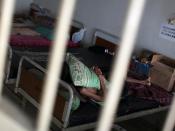HIV stands for Immunodeficiency Virus, which is the virus that causes AIDS. HIV infects the immune cells which are required to protect the body against infections and diseases. Most people with HIV will eventually develop AIDS as a result of their HIV infection. When HIV finds a home within a living organism, it replicates (begins to make copies of itself) within this organism's cells. It can damage the cells it replicates in, which is one of the things that can make the infected person become ill.
AIDS is short for Acquired Immunodeficiency Syndrome and applies to the most advanced stages of HIV infection.
HIV/AIDS is most commonly spread by coming into direct contact with blood, semen or vaginal fluids during unprotected sex with an infected partner. Also a common way of transmission is through the use of shared needles that have infected blood in them. Being born to a mother who has the virus can lead to the transmission of HIV/AIDS through the use of breast milk.
Small amounts of HIV are found in saliva but there is not enough to transfer the virus. Kissing somebody with the virus will not transfer the virus. HIV is not present in urine, feces, Vomit and sweat. You cannot be infected by sharing food utensils with a infected person or by having somebody with HIV or AIDS hug, kiss, spit, sneeze, cough, breathe, sweat, or cry on you.
HIV/AIDS in South Africa
Aids kills some 6,000 people each day in Africa - more than wars, famines and floods. Millions of children are orphans, many more live with HIV or Aids. UNAIDS estimates that at the end of 2003 there were 5.3 million people in South Africa living with HIV - 21.5% of the population.
This table provided by AVERT.ORG explains the current statistics...


